Useful Edible Weeds
When Ken and Addy Fern were actively working on their experimental plot in Cornwall, visitors would have noticed the large amount of weeds that grew there. This was partly because they simply didn't have enough time to keep on top of all the weeds, but also because many are quite useful, and some were even actively encouraged. Their approach was that a weed is merely a plant growing somewhere they didn't want it to grow and, instead of automatically hoeing out any plant that didn't put there, try and leave in all those that are not likely to interfere with the other plants they were growing.
There are several ways in which weeds can be helpful to leave in the garden. Many of them, for example, are edible (indeed some are very tasty), whilst others have medicinal properties or other uses. Weeds also help to provide a more balanced environment by providing food and habitats for insects and other creatures - this can have a very important knock-on effect for the gardener by encouraging beneficial insects and birds and thus reducing insect predation on our plants. In addition, weeds help to protect and feed the soil by providing good compost material as well as by covering it and preventing erosion.
Whilst, with a few notable exceptions, we would not recommend deliberately introducing weeds into the garden, it is quite possible to co-exist happily with many of them, particularly many of the annual species such as bittercress, chickweed and shepherd’s purse. It is simply a matter of making sure you weed out most of the seedlings, leaving a few to grow on and then allowing them to set seed. There are, however, some perennials, such as couch grass and Japanese knotweed, which are so vigorous that they really cannot be tolerated in amongst your prize plants -they will simply swamp them.
The following list includes some of the weeds that can be particularly useful, though not all plants listed should be tolerated due to their aggressive tendencies.
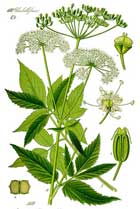 Aegopodium podagraria. Ground Elder is a vigorous and very invasive perennial, growing about 60cm tall and spreading rapidly by its roots. It is very difficult to eradicate because any small piece of root left in the ground will quickly regrow. Whilst it is occasionally grown as a ground cover in the wilder parts of the garden (shrubs and strong growing bulbs such as some lilies grow very well through it), it really is too vigorous for most other herbaceous species. There is, however, a variegated form of this species that is less invasive and is sometimes grown in the ornamental garden. Ground Elder has a long history of edible and medicinal use; indeed it was cultivated as a food crop and medicinal herb in the Middle Ages. It was used mainly as a food that could counteract gout, one of the effects of the rich foods eaten by monks, bishops etc at this time. The leaves can be eaten raw or cooked and have an unusual tangy flavour which is an acquired taste, although some people like it.
Aegopodium podagraria. Ground Elder is a vigorous and very invasive perennial, growing about 60cm tall and spreading rapidly by its roots. It is very difficult to eradicate because any small piece of root left in the ground will quickly regrow. Whilst it is occasionally grown as a ground cover in the wilder parts of the garden (shrubs and strong growing bulbs such as some lilies grow very well through it), it really is too vigorous for most other herbaceous species. There is, however, a variegated form of this species that is less invasive and is sometimes grown in the ornamental garden. Ground Elder has a long history of edible and medicinal use; indeed it was cultivated as a food crop and medicinal herb in the Middle Ages. It was used mainly as a food that could counteract gout, one of the effects of the rich foods eaten by monks, bishops etc at this time. The leaves can be eaten raw or cooked and have an unusual tangy flavour which is an acquired taste, although some people like it.
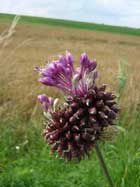 Allium vineale. Crow Garlic is a perennial bulb that grows up to 60cm tall. As a weed, it is most likely to be found in lawns that are not cut very regularly and spreads by means of the small bulbils that it produces instead of flowers. Both the bulbs and the bulbils have a rather strong garlic-like flavour -the bulbs
Allium vineale. Crow Garlic is a perennial bulb that grows up to 60cm tall. As a weed, it is most likely to be found in lawns that are not cut very regularly and spreads by means of the small bulbils that it produces instead of flowers. Both the bulbs and the bulbils have a rather strong garlic-like flavour -the bulbs
can be harvested virtually all year round whilst the bulbils are ready in the summer. The leaves are also edible, with a similar flavour, but tend to have a stringy texture.
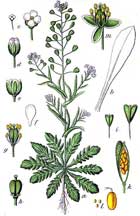 Capsella bursa-pastoris. Shepherd’s Purse is an annual plant growing up to 50cm tall in rich soils, but much smaller in poor ones. A very common garden weed, it can flower and produce seeds all year round and will often spread freely in cultivated ground. This species is a prime example of how a plant can be viewed as an annoying weed in some areas of the world, whilst in others it is actually cultivated for its wide range of uses. It is extensively cultivated in some areas of the world as a cabbage-flavoured spring greens, whilst in Japan it is one of the essential ingredients of a ceremonial rice and barley gruel that is eaten on January 7th. The leaves grow rather larger under cultivation, they can be harvested about a month after sowing and can be treated as a cut and come again crop. The young leaves, used before the plant comes into flower, make a fine addition to salads, whilst older leaves are a cress and cabbage substitute, becoming peppery with age. The young flowering shoots can be eaten in the same way as broccoli. They are rather thin and fiddly but the taste is quite acceptable. The seed is rich in oil and, although small and very fiddly to harvest, can be eaten raw or cooked - it used to be ground into a meal and used in soups etc. The seedpods can be used as a peppery seasoning for soups and stews, whilst the fresh or dried root is used as a ginger substitute. The plant has long been used as a domestic herbal remedy, particularly in the treatment of both internal and external bleeding, diarrhoea etc. The seed, when placed in water, attracts mosquitoes. It has a gummy substance that binds the insects mouth to the seed. The seed also releases a substance toxic to the larvae - a kilo of seed is said to be able to kill 10 million larvae.
Capsella bursa-pastoris. Shepherd’s Purse is an annual plant growing up to 50cm tall in rich soils, but much smaller in poor ones. A very common garden weed, it can flower and produce seeds all year round and will often spread freely in cultivated ground. This species is a prime example of how a plant can be viewed as an annoying weed in some areas of the world, whilst in others it is actually cultivated for its wide range of uses. It is extensively cultivated in some areas of the world as a cabbage-flavoured spring greens, whilst in Japan it is one of the essential ingredients of a ceremonial rice and barley gruel that is eaten on January 7th. The leaves grow rather larger under cultivation, they can be harvested about a month after sowing and can be treated as a cut and come again crop. The young leaves, used before the plant comes into flower, make a fine addition to salads, whilst older leaves are a cress and cabbage substitute, becoming peppery with age. The young flowering shoots can be eaten in the same way as broccoli. They are rather thin and fiddly but the taste is quite acceptable. The seed is rich in oil and, although small and very fiddly to harvest, can be eaten raw or cooked - it used to be ground into a meal and used in soups etc. The seedpods can be used as a peppery seasoning for soups and stews, whilst the fresh or dried root is used as a ginger substitute. The plant has long been used as a domestic herbal remedy, particularly in the treatment of both internal and external bleeding, diarrhoea etc. The seed, when placed in water, attracts mosquitoes. It has a gummy substance that binds the insects mouth to the seed. The seed also releases a substance toxic to the larvae - a kilo of seed is said to be able to kill 10 million larvae.
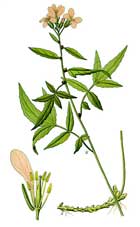 Cardamine species. Bittercress is a very common annual garden weed, growing just 1cm tall in very poor soils but up to 30cm in richer conditions. It spreads very freely by means of its seeds but is easily controlled by hoeing. It also tends to like growing in pots and it can be time consuming having to weed pot plants by hand. There are two main species found in gardens, the hairy bittercress C. hirsuta, and wavy bittercress C. flexuosa. Bittercress can be in flower all year round, especially if the winter is mild. Both the leaves and flowers can be eaten, raw and cooked. They have a hot cress-like flavour and can be used as a garnish or flavouring in salads, though they can also be used as a potherb.
Cardamine species. Bittercress is a very common annual garden weed, growing just 1cm tall in very poor soils but up to 30cm in richer conditions. It spreads very freely by means of its seeds but is easily controlled by hoeing. It also tends to like growing in pots and it can be time consuming having to weed pot plants by hand. There are two main species found in gardens, the hairy bittercress C. hirsuta, and wavy bittercress C. flexuosa. Bittercress can be in flower all year round, especially if the winter is mild. Both the leaves and flowers can be eaten, raw and cooked. They have a hot cress-like flavour and can be used as a garnish or flavouring in salads, though they can also be used as a potherb.
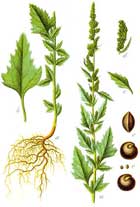 Chenopodium album. Fat Hen is another annual weed that used to be cultivated as a food plant. Growing about 80cm tall, it was at one time often grown for its edible leaves. There is still one named variety that can sometimes be obtained - called ‘Magenta’ in reference to the colour of its leaves, it is considered by some people to be the best tasting of all potherbs. The leaves are a very acceptable spinach substitute, the taste is a little bland but this can be improved by adding a few stronger-flavoured leaves. The young flowering stems can also be eaten in much the same way as broccoli. The edible seed, which is somewhat fiddly to harvest, can be dried and ground into a meal and eaten raw or baked into bread. It can also be sprouted and added to salads. The seed should be soaked in water overnight and thoroughly rinsed before being used in order to remove any bitter-tasting saponins.
Chenopodium album. Fat Hen is another annual weed that used to be cultivated as a food plant. Growing about 80cm tall, it was at one time often grown for its edible leaves. There is still one named variety that can sometimes be obtained - called ‘Magenta’ in reference to the colour of its leaves, it is considered by some people to be the best tasting of all potherbs. The leaves are a very acceptable spinach substitute, the taste is a little bland but this can be improved by adding a few stronger-flavoured leaves. The young flowering stems can also be eaten in much the same way as broccoli. The edible seed, which is somewhat fiddly to harvest, can be dried and ground into a meal and eaten raw or baked into bread. It can also be sprouted and added to salads. The seed should be soaked in water overnight and thoroughly rinsed before being used in order to remove any bitter-tasting saponins.
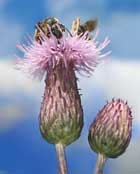 Cirsium species. There are many different species of thistle, the two you are most likely to encounter as weeds are C. arvense, the Creeping Thistle a perennial plant growing to about 90cm, and C. vulgare, the Common Thistle which is biennial and grows up to 2 metres tall. These are very aggressive weeds, the first spreading freely by means of its roots and the other sending its seeds far and wide to grow where you least expect them. The young roots of both species can be eaten raw or cooked. Although nutritious, they are rather bland with a taste reminiscent of Jerusalem artichokes. They are probably best when used in a mixture with other vegetables. Be warned though, just like Jerusalem artichokes the root is rich in inulin, a starch that cannot be digested by humans. This starch thus passes straight through the digestive system and, in some people, ferments to produce flatulence. The young stems can be peeled and cooked like asparagus or rhubarb. Young leaves have a fairly bland flavour and can also be eaten raw or cooked, but the prickles need to be removed before the leaves can be eaten - not only is this rather fiddly but very little edible leaf remains.
Cirsium species. There are many different species of thistle, the two you are most likely to encounter as weeds are C. arvense, the Creeping Thistle a perennial plant growing to about 90cm, and C. vulgare, the Common Thistle which is biennial and grows up to 2 metres tall. These are very aggressive weeds, the first spreading freely by means of its roots and the other sending its seeds far and wide to grow where you least expect them. The young roots of both species can be eaten raw or cooked. Although nutritious, they are rather bland with a taste reminiscent of Jerusalem artichokes. They are probably best when used in a mixture with other vegetables. Be warned though, just like Jerusalem artichokes the root is rich in inulin, a starch that cannot be digested by humans. This starch thus passes straight through the digestive system and, in some people, ferments to produce flatulence. The young stems can be peeled and cooked like asparagus or rhubarb. Young leaves have a fairly bland flavour and can also be eaten raw or cooked, but the prickles need to be removed before the leaves can be eaten - not only is this rather fiddly but very little edible leaf remains.
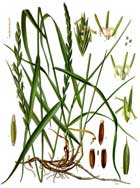 Elytrigia repens. Couch grass is one of the most pernicious weeds that gardeners have to contend with. It would be a very brave or very foolish person who would encourage this perennial grass into their garden. Growing about 50cm tall, the roots spread quickly through the soil, growing into the roots of other plants and making them almost impossible to get out. Even a small section of root left in the soil will quickly start growing again. Despite its antisocial tendency in the garden, however, couch is a very useful herbal medicine and the famous Herbalist Culpepper is said to have stated that half an acre of couch was worth five acres of carrots twice over. The edible uses of couch are very minor. The roots have been dried and ground into a powder, then used with wheat when making bread. Although thin and stringy, they contain starch and enzymes and are quite sweet. When boiled for a long time to break down the leathery membrane, syrup can be made from the roots and this is sometimes brewed into a beer. When roasted, the root has been ground into a powder and used as a healthier coffee substitute. Couch grass, however, is of considerable value as a herbal medicine -a decoction of the roots being very useful in the treatment of a wide range of kidney, liver and urinary disorders. They have a gentle remedial effect that is well tolerated by the body and has no side effects. This plant is also a favourite medicine of domestic cats and dogs, which will often eat quite large quantities of the leaves.
Elytrigia repens. Couch grass is one of the most pernicious weeds that gardeners have to contend with. It would be a very brave or very foolish person who would encourage this perennial grass into their garden. Growing about 50cm tall, the roots spread quickly through the soil, growing into the roots of other plants and making them almost impossible to get out. Even a small section of root left in the soil will quickly start growing again. Despite its antisocial tendency in the garden, however, couch is a very useful herbal medicine and the famous Herbalist Culpepper is said to have stated that half an acre of couch was worth five acres of carrots twice over. The edible uses of couch are very minor. The roots have been dried and ground into a powder, then used with wheat when making bread. Although thin and stringy, they contain starch and enzymes and are quite sweet. When boiled for a long time to break down the leathery membrane, syrup can be made from the roots and this is sometimes brewed into a beer. When roasted, the root has been ground into a powder and used as a healthier coffee substitute. Couch grass, however, is of considerable value as a herbal medicine -a decoction of the roots being very useful in the treatment of a wide range of kidney, liver and urinary disorders. They have a gentle remedial effect that is well tolerated by the body and has no side effects. This plant is also a favourite medicine of domestic cats and dogs, which will often eat quite large quantities of the leaves.
 Epilobium angustifolium. With its tiny seed that floats so well on the air, rosebay willow herb will find its way to your garden without the need for you to invite it in. Left to its own devices, this perennial plant will then spread rapidly at the roots to form large clumps up to 2 metres tall. It produces spikes of flowers through much of the summer and, if it weren’t so aggressive, it would surely merit a place in the ornamental garden.
Epilobium angustifolium. With its tiny seed that floats so well on the air, rosebay willow herb will find its way to your garden without the need for you to invite it in. Left to its own devices, this perennial plant will then spread rapidly at the roots to form large clumps up to 2 metres tall. It produces spikes of flowers through much of the summer and, if it weren’t so aggressive, it would surely merit a place in the ornamental garden.
The young leaves and shoot tips have been used in salads or cooked as a vegetable. When boiled they are said to make a wholesome vegetable and are a good source of vitamins A and C. The root can be eaten raw, cooked or dried and ground into a powder. When used in spring, it is said to have a sweet taste. The flower stalks, picked when the flowers are still in bud, can be eaten raw or cooked. The pith of young or older stems is slightly sweet, tender and quite pleasing to eat, though there is not much of it. A sweet and pleasant tea can be made from the dried leaves - it can be consumed on its own or mixed with conventional tea. Rosebay willow herb has often been used as a domestic herbal remedy, particularly to treat conditions such as diarrhoea and irritable bowel syndrome; it is used in Germany and Austria to treat prostate problems and a poultice of the leaves is applied to mouth ulcers. A poultice made from the peeled roots is applied to burns, skin sores, swellings, boils etc. A fibre obtained from the outer stems is used to make cordage, whilst the ‘cottony’ seed hairs are used as a stuffing material in toys etc or as tinder to start fires.
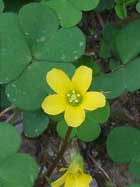 Oxalis corniculata. Yellow Sorrel is a low-growing annual or short-lived perennial plant, rarely more than 1cm tall but spreading to form clumps 15cm or more across. This is another weed we that can become a nuisance if it gets into pot plants, where it spreads rapidly by seed and underground bulbils. Both the leaves and the flowers have a pleasant acid flavour, rather like sorrel. They are very small and fiddly to harvest, but can be added to salads.
Oxalis corniculata. Yellow Sorrel is a low-growing annual or short-lived perennial plant, rarely more than 1cm tall but spreading to form clumps 15cm or more across. This is another weed we that can become a nuisance if it gets into pot plants, where it spreads rapidly by seed and underground bulbils. Both the leaves and the flowers have a pleasant acid flavour, rather like sorrel. They are very small and fiddly to harvest, but can be added to salads.
The leaves are used as an antidote to poisoning by the seeds of Datura spp, arsenic and mercury, and the leaf juice has a soothing effect when applied to insect bites, burns and skin eruptions.
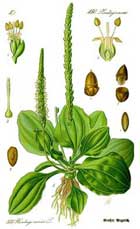 Plantago major. Common Plantain is a common lawn weed. This perennial plant grows up to 20cm tall, though it will be much lower when growing in a frequently cut lawn. Although most gardeners mercilessly root it out of their lawns, it actually does no harm when growing there and, indeed, helps to maintain the fertility of the lawn. The young leaves are rather bitter and tedious to prepare because the fibrous strands need to be removed before use, but they have been used as a potherb. It is best not to use the leaf stalk since this is even more fibrous than the leaf. They can be blanched in boiling water before using them in salads in order to make them more tender. Although very tedious to harvest, the seed can be ground into a meal and mixed with flour when making bread, cakes etc. The whole seed can also be boiled and used like sago. Common plantain is a safe and effective medicinal herb. The leaves are used externally as a healing poultice and treatment for bleeding, quickly staunching blood flow and encouraging the repair of damaged tissue. Internally, they are used in the treatment of a wide range of complaints including diarrhoea, gastritis, peptic ulcers, irritable bowel syndrome, haemorrhage, haemorrhoids, cystitis, bronchitis, catarrh, sinusitis, asthma and hay fever. Plantain seed husks are an excellent treatment for digestive disorders. They contain up to 30% mucilage that swells up in the gut, acting as a bulk laxative and soothing irritated membranes.
Plantago major. Common Plantain is a common lawn weed. This perennial plant grows up to 20cm tall, though it will be much lower when growing in a frequently cut lawn. Although most gardeners mercilessly root it out of their lawns, it actually does no harm when growing there and, indeed, helps to maintain the fertility of the lawn. The young leaves are rather bitter and tedious to prepare because the fibrous strands need to be removed before use, but they have been used as a potherb. It is best not to use the leaf stalk since this is even more fibrous than the leaf. They can be blanched in boiling water before using them in salads in order to make them more tender. Although very tedious to harvest, the seed can be ground into a meal and mixed with flour when making bread, cakes etc. The whole seed can also be boiled and used like sago. Common plantain is a safe and effective medicinal herb. The leaves are used externally as a healing poultice and treatment for bleeding, quickly staunching blood flow and encouraging the repair of damaged tissue. Internally, they are used in the treatment of a wide range of complaints including diarrhoea, gastritis, peptic ulcers, irritable bowel syndrome, haemorrhage, haemorrhoids, cystitis, bronchitis, catarrh, sinusitis, asthma and hay fever. Plantain seed husks are an excellent treatment for digestive disorders. They contain up to 30% mucilage that swells up in the gut, acting as a bulk laxative and soothing irritated membranes.
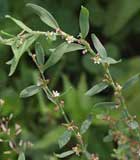 Polygonum aviculare. Knotweed is an annual plant growing to 30cm in height. It is a common and invasive weed of cultivated ground, spreading by seed but quite easily controlled. It is an important food plant for the caterpillars of many species of butterflies and also produces an abundance of seeds that are a favourite food for many species of birds. Young leaves and plants can be used as a potherb; they are a very rich source of zinc. The seed, which is rather small and fiddly to utilize, can be used in all the ways that buckwheat (Fagopyrum esculentum) is used, either whole or dried and ground into a powder for use in pancakes, biscuits and piñole. Knotweed is a safe and effective astringent and diuretic herb that is used mainly in the treatment of complaints such as bleeding, dysentery and haemorrhoids. It is also taken in the treatment of pulmonary complaints because the silicic acid it contains strengthens connective tissue in the lungs. Recent research has shown that knotweed paste applied internally is a useful medicine in the treatment of bacterial dysentery. The plant yields a blue dye that is not much inferior to indigo, whilst yellow and green dyes can also be obtained.
Polygonum aviculare. Knotweed is an annual plant growing to 30cm in height. It is a common and invasive weed of cultivated ground, spreading by seed but quite easily controlled. It is an important food plant for the caterpillars of many species of butterflies and also produces an abundance of seeds that are a favourite food for many species of birds. Young leaves and plants can be used as a potherb; they are a very rich source of zinc. The seed, which is rather small and fiddly to utilize, can be used in all the ways that buckwheat (Fagopyrum esculentum) is used, either whole or dried and ground into a powder for use in pancakes, biscuits and piñole. Knotweed is a safe and effective astringent and diuretic herb that is used mainly in the treatment of complaints such as bleeding, dysentery and haemorrhoids. It is also taken in the treatment of pulmonary complaints because the silicic acid it contains strengthens connective tissue in the lungs. Recent research has shown that knotweed paste applied internally is a useful medicine in the treatment of bacterial dysentery. The plant yields a blue dye that is not much inferior to indigo, whilst yellow and green dyes can also be obtained.
Polygonum japonicum. Japanese Knotweed is not the sort of plant to encourage or even tolerate in the garden. A perennial growing 2 metres or more tall, it spreads very rapidly at the roots to form dense clumps that smother any other plant growing there. Since its introduction from the East, it has become one of our most pernicious weeds, so vigorous that the roots have even managed to send up shoots through tarmac! However, as with all plants, it is not all bad news. A report on the Natural History Programme of the BBC stated that Japanese knotweed is actually becoming a very valuable habitat for spiders, frogs, grass snakes and many other creatures. Its hollow stems allow a wide variety of insects and other small creatures to overwinter and find hiding places, thus a greater abundance of food is provided for insectivores such as frogs, who are themselves eaten by grass snakes. In areas of north Wales where Japanese knotweed has run rife, it is now the primary habitat for grass snakes. The plant also has several edible uses. The young shoots, which have a mild acid flavour, can be eaten in spring, either cooked in the same way as asparagus or used as a rhubarb substitute in pies, fruit soups, jams etc. The seed can be ground into a powder and used as a flavouring and thickener in soups etc, or can be mixed with cereals when making bread, cakes etc.
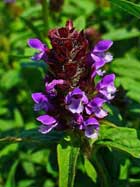 Prunella vulgaris. Self Heal is a perennial plant, growing up to 15cm tall and often found as a weed in the lawn. The leaves have a somewhat bitter flavour but can be used in salads, soups, stews etc. The bitterness can be reduced or even removed by washing the leaves prior to use. A cold water infusion of the freshly chopped or dried and powdered leaves is used as a very tasty refreshing beverage. Medicinally, self heal has a long history of folk use, especially in the treatment of wounds, ulcers, sores etc. It was also taken internally as a tea in the treatment of conditions such as fevers, diarrhoea, sore mouth and internal bleeding. An olive-green dye can be obtained from the flowers and stems.
Prunella vulgaris. Self Heal is a perennial plant, growing up to 15cm tall and often found as a weed in the lawn. The leaves have a somewhat bitter flavour but can be used in salads, soups, stews etc. The bitterness can be reduced or even removed by washing the leaves prior to use. A cold water infusion of the freshly chopped or dried and powdered leaves is used as a very tasty refreshing beverage. Medicinally, self heal has a long history of folk use, especially in the treatment of wounds, ulcers, sores etc. It was also taken internally as a tea in the treatment of conditions such as fevers, diarrhoea, sore mouth and internal bleeding. An olive-green dye can be obtained from the flowers and stems.
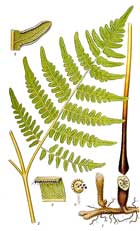 Pteridium aquilinum. Bracken is an extremely invasive plant and is a noxious weed. It is one of the most widespread plants in the world, being found in all parts of the globe other than the extreme north and south. A perennial plant, growing about 1.2 metres tall, it spreads freely both by the roots and its dust-like spores that can travel hundreds of miles in the air. The plant has a number of edible uses, with the roots and young shoots being eaten. However, there is also evidence to suggest that regular consumption of the plant could cause cancer, so eating it is not recommended.
Pteridium aquilinum. Bracken is an extremely invasive plant and is a noxious weed. It is one of the most widespread plants in the world, being found in all parts of the globe other than the extreme north and south. A perennial plant, growing about 1.2 metres tall, it spreads freely both by the roots and its dust-like spores that can travel hundreds of miles in the air. The plant has a number of edible uses, with the roots and young shoots being eaten. However, there is also evidence to suggest that regular consumption of the plant could cause cancer, so eating it is not recommended.
There are also many non-edible uses. For example: a glue can be made from the rootstock; the rhizome lathers readily in water and can be used as a soap; the roots have been rubbed into the scalp in order to promote hair growth; the ashes of the plant are rich in potassium and can be used as a fertilizer and also in making glass; the dried ferns produce a very durable thatch and the fibrous remnants from edible roots make a good tinder. In addition, the leaves are used as a packing material for fruit, keeping it fresh and cool without imparting any colour or flavour. They can also be used as a lining for baskets, fruit drying racks etc where they help to repel insects and can also help to prevent rot in the fruits. The dried fronds are very useful in the garden as a mulch for somewhat tender plants. This will keep the soil warmer, protect from wind damage and also keep off some of the rain.
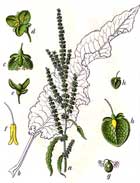 Rumex crispus. Curled Dock is a perennial plant growing about 60cm tall. It is considered to be a serious weed of agriculture but perhaps it should be tolerated as much as possible because it is such a good plant for re-establishing fertility in the soil -its deep roots bring up nutriments that would otherwise be lost whilst its leaves make excellent compost. It is also a very important food plant for the caterpillars of many species of butterfly.
Rumex crispus. Curled Dock is a perennial plant growing about 60cm tall. It is considered to be a serious weed of agriculture but perhaps it should be tolerated as much as possible because it is such a good plant for re-establishing fertility in the soil -its deep roots bring up nutriments that would otherwise be lost whilst its leaves make excellent compost. It is also a very important food plant for the caterpillars of many species of butterfly.
Although rather bitter, the very nutritious leaves have been used in mixed salads, cooked as a potherb or added to soups. Only the very young leaves should be used, preferably before the stems have developed, and even these are likely to be bitter. The inner portion of the stems is also eaten whilst the seed can be used as a piñole or can be ground into a powder and used as flour for making pancakes etc. When roasted, the seed has been used as a coffee substitute. Curled dock has a long history of domestic herbal use. It is a gentle and safe laxative, less powerful than rhubarb in its action so it is particularly useful in the treatment of mild constipation. The plant has valuable cleansing properties and is useful for treating a wide range of skin problem. All parts of the plant can be used, though the root is most active medicinally.
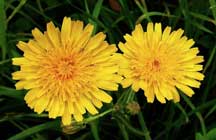 Sonchus arvensis. Field Milk Thistle is a common garden weed that has occasionally been cultivated as a food plant -in Indonesia they have even produced improved varieties selected for their edible leaves. A perennial growing up to 1.2 metres tall, it spreads by means of seed and its creeping rootstock. The young leaves have a slightly bitter taste but can be added to salads or cooked like spinach. It might be best, though it is not necessary, to remove the marginal prickles. The mild flavoured stems can be cooked like asparagus or rhubarb, whilst the roasted root is used as a coffee substitute.
Sonchus arvensis. Field Milk Thistle is a common garden weed that has occasionally been cultivated as a food plant -in Indonesia they have even produced improved varieties selected for their edible leaves. A perennial growing up to 1.2 metres tall, it spreads by means of seed and its creeping rootstock. The young leaves have a slightly bitter taste but can be added to salads or cooked like spinach. It might be best, though it is not necessary, to remove the marginal prickles. The mild flavoured stems can be cooked like asparagus or rhubarb, whilst the roasted root is used as a coffee substitute.
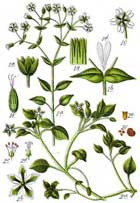 Stellaria media. A very common garden weed, chickweed grows, flowers and sets seed all year round. An annual plant growing about 15cm it spreads by means of seeds. It is very easy to control by hoeing and it has many beneficial uses. The young leaves have a mild flavour and can be available all year round if the winter is not too severe. Very nutritious, they can be eaten raw in mixed salads, or cooked to make a very acceptable spinach substitute. The small seed can be ground into a powder and used in making bread or to thicken soups. Chickweed has a very long history of herbal use, being particularly beneficial in the external treatment of any kind of itching skin condition. It has been known to soothe severe itchiness even where all other remedies have failed. When applied as a poultice, it will relieve any kind of roseola and is effective wherever there are fragile superficial veins. An infusion of the fresh or dried herb can be added to the bath water and its emollient property will help to reduce inflammation -in rheumatic joints for example - and encourage tissue repair.
Stellaria media. A very common garden weed, chickweed grows, flowers and sets seed all year round. An annual plant growing about 15cm it spreads by means of seeds. It is very easy to control by hoeing and it has many beneficial uses. The young leaves have a mild flavour and can be available all year round if the winter is not too severe. Very nutritious, they can be eaten raw in mixed salads, or cooked to make a very acceptable spinach substitute. The small seed can be ground into a powder and used in making bread or to thicken soups. Chickweed has a very long history of herbal use, being particularly beneficial in the external treatment of any kind of itching skin condition. It has been known to soothe severe itchiness even where all other remedies have failed. When applied as a poultice, it will relieve any kind of roseola and is effective wherever there are fragile superficial veins. An infusion of the fresh or dried herb can be added to the bath water and its emollient property will help to reduce inflammation -in rheumatic joints for example - and encourage tissue repair.
 Taraxacum officinale. Dandelions are another of those weeds that is at times cultivated for its edible leaves - indeed there are a number of named varieties that have been developed in Europe. A perennial plant growing up to 40cm tall, it may be perhaps be encouraged in a lawn, but in cultivated beds it tends to provide a hiding place for slugs under the leaves. The plant spreads very freely by means of its light seeds, but is easily controlled by hoeing. The leaves are literally packed full of vitamins and minerals, making this one of the most nutritious leaves you can eat. Unfortunately, they have a rather bitter flavour, though we find a few of the leaves added to a mixed salad to be quite acceptable. The bitter tasting root can also be cooked; some people say they have a turnip-like flavour.
Taraxacum officinale. Dandelions are another of those weeds that is at times cultivated for its edible leaves - indeed there are a number of named varieties that have been developed in Europe. A perennial plant growing up to 40cm tall, it may be perhaps be encouraged in a lawn, but in cultivated beds it tends to provide a hiding place for slugs under the leaves. The plant spreads very freely by means of its light seeds, but is easily controlled by hoeing. The leaves are literally packed full of vitamins and minerals, making this one of the most nutritious leaves you can eat. Unfortunately, they have a rather bitter flavour, though we find a few of the leaves added to a mixed salad to be quite acceptable. The bitter tasting root can also be cooked; some people say they have a turnip-like flavour.
When roasted and ground into a powder, they can be used as a much healthier alternative to coffee. The dandelion is a commonly used herbal remedy. It is especially effective and valuable as a diuretic because it contains high levels of potassium salts and therefore can replace the potassium that is lost from the body when diuretics are used. The latex contained in the plant sap can be used to remove corns, warts and verrucae. The latex has a specific action on inflammations of the gall bladder and is also believed to remove stones in the liver.
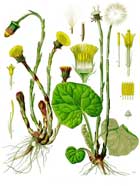 Tussilago farfara. Coltsfoot has a very aggressive root system and will spread very freely if given half a chance. Indeed, it has been shown that the rhizomes can lay dormant in the soil for many years, finally emerging and resuming growth when the soil is disturbed. All in all, this is not a plant to encourage in the garden unless you choose your site with care or find some means of restraining it such as by planting in a large tub that is buried in the ground. A perennial plant, it grows up to 20cm tall, sending up flowering stems in the spring, with the leaves only appearing after it has finished flowering. This habit has led people in the past to believing that the flowers and the leaves were two different plants. All parts of the plant can be eaten, but most have a rather bitter flavour. The flower buds and young flowers, however, have a pleasant aniseed flavour and add a distinctive aromatic flavour to salads. An effective demulcent and expectorant herb, coltsfoot is one of the most popular European remedies for the treatment of a wide range of chest complaints, soothing coughs and helping to get rid of catarrh. It is widely available in health food shops, often in the form of a candied sweet.
Tussilago farfara. Coltsfoot has a very aggressive root system and will spread very freely if given half a chance. Indeed, it has been shown that the rhizomes can lay dormant in the soil for many years, finally emerging and resuming growth when the soil is disturbed. All in all, this is not a plant to encourage in the garden unless you choose your site with care or find some means of restraining it such as by planting in a large tub that is buried in the ground. A perennial plant, it grows up to 20cm tall, sending up flowering stems in the spring, with the leaves only appearing after it has finished flowering. This habit has led people in the past to believing that the flowers and the leaves were two different plants. All parts of the plant can be eaten, but most have a rather bitter flavour. The flower buds and young flowers, however, have a pleasant aniseed flavour and add a distinctive aromatic flavour to salads. An effective demulcent and expectorant herb, coltsfoot is one of the most popular European remedies for the treatment of a wide range of chest complaints, soothing coughs and helping to get rid of catarrh. It is widely available in health food shops, often in the form of a candied sweet.
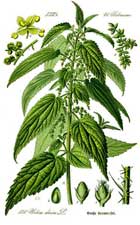 Urtica dioica. If there is one plant that every child learns to recognise, it is the stinging nettle. Just one brush up against the stinging hairs on its leaves is enough to produce a lasting memory! A perennial plant, it grows up to 1.2 metres tall and can form very extensive clumps spreading both at the roots and by seed. Apart from its many uses for humans, this is a superb wildlife plant. It can be a nuisance in cultivated areas, but it should be allowed to grow in out of the way places. Stinging nettles have a huge range of uses, only a few of which are mentioned here. The young leaves can be eaten cooked -although they can sting you when raw, once they are cooked they are perfectly harmless and make one of the most nutrient-rich foods you can eat. Do make sure you use gloves or other protection when harvesting and washing them though! Do not harvest leaves from plants that have started to flower, however, since these can develop gritty particles called cystoliths that act as an irritant to the kidneys. If you cut the plants down twice a year, just before they start to flower, then you will ensure a good supply of fresh young leaves in the summer and will also prevent the clump from becoming too vigorous. Cutting them more than twice a year will severely weaken them and probably kill them over a period of 2-3 years.
Urtica dioica. If there is one plant that every child learns to recognise, it is the stinging nettle. Just one brush up against the stinging hairs on its leaves is enough to produce a lasting memory! A perennial plant, it grows up to 1.2 metres tall and can form very extensive clumps spreading both at the roots and by seed. Apart from its many uses for humans, this is a superb wildlife plant. It can be a nuisance in cultivated areas, but it should be allowed to grow in out of the way places. Stinging nettles have a huge range of uses, only a few of which are mentioned here. The young leaves can be eaten cooked -although they can sting you when raw, once they are cooked they are perfectly harmless and make one of the most nutrient-rich foods you can eat. Do make sure you use gloves or other protection when harvesting and washing them though! Do not harvest leaves from plants that have started to flower, however, since these can develop gritty particles called cystoliths that act as an irritant to the kidneys. If you cut the plants down twice a year, just before they start to flower, then you will ensure a good supply of fresh young leaves in the summer and will also prevent the clump from becoming too vigorous. Cutting them more than twice a year will severely weaken them and probably kill them over a period of 2-3 years.
Nettles have a very long history of herbal use and modern research has shown the justification for this. For example, a tea made from the leaves has traditionally been used as a cleansing tonic and blood purifier so the plant is often used in the treatment of hay fever, arthritis, anaemia etc. The roots contain substances that have been shown to have a beneficial effect upon the prostate and it is now used in a very effective formula to treat an enlarged prostate. The fresh leaves of nettles have been rubbed or beaten onto the skin in the treatment of rheumatism etc. This practice, called urtification, causes intense irritation to the skin as it is stung by the nettles. It is believed that this treatment works in two ways. Firstly, it acts as a counter-irritant, bringing more blood to the area to help remove the toxins that cause rheumatism. Secondly, the formic acid from the nettles is believed to have a beneficial effect upon the rheumatic joints.
A strong flax-like fibre obtained from the stems is used for making string, cloth and a good quality paper. The leaves are an excellent addition to the compost heap and can be soaked for 7-21 days in water to make a very nutritious liquid feed for plants. This liquid feed is both insect repellent and a good foliar feed. A hair wash is made from the infused leaves and this is used as a tonic and anti-dandruff treatment. A beautiful and permanent green dye is obtained from a decoction of the leaves and stems.
We hope that this leaflet has given you a fresh insight into all those plants that we usually classify as weeds and spend a lot of time and effort in trying to eradicate from our gardens.
Database
The database has more details on these plants: Aegopodium podagraria, Allium vineale, Capsella bursa-pastoris, Cardamine flexuosa, Cardamine hirsuta, Chenopodium album, Cirsium arvense, Cirsium vulgare, Elytrigia repens, Epilobium angustifolium, Oxalis corniculata, Plantago major, Polygonum aviculare, Polygonum japonicum, Prunella vulgaris, Pteridium aquilinum, Rumex crispus, Sonchus arvensis, Stellaria media, Taraxacum officinale, Tussilago farfara, Urtica dioica.